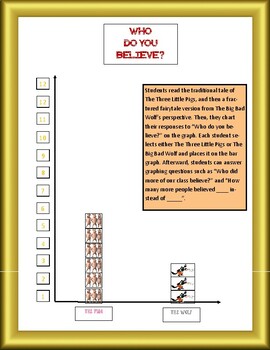Fractured Fairytale Graphing: Three Little Pigs vs. The Big Bad Wolf
Pre-k On Mars
5 Followers
Grade Levels
PreK - 2nd
Subjects
Resource Type
Standards
CCSSK.CC.C.6
CCSSK.MD.A.2
CCSSK.MD.B.3
CCSSMP4
Formats Included
- Publisher files
Pre-k On Mars
5 Followers
Description
Engage your students in an interactive STEM activity, graphing their opinions on who told the truth, The Three Little Pigs or The Big Bad Wolf!
Included:
Title Question
Numbers for measuring each category
Category Labels - The Pigs/The Wolf
Three Little Pigs graphing cards
Big Bad Wolf graphing cards
I would recommend using any copy of The Three Little Pigs traditional tale and either "The True Story of The Three Little Pigs" by Jon Scieszka and Lane Smith or "No Lie, Pigs (And Their Houses) Can Fly! The Story of The Three Little Pigs: As Told By The Wolf" by Jessica Gunderson.
Total Pages
Answer Key
N/A
Teaching Duration
N/A
Report this resource to TPT
Reported resources will be reviewed by our team. Report this resource to let us know if this resource violates TPT’s content guidelines.
Standards
to see state-specific standards (only available in the US).
CCSSK.CC.C.6
Identify whether the number of objects in one group is greater than, less than, or equal to the number of objects in another group, e.g., by using matching and counting strategies.
CCSSK.MD.A.2
Directly compare two objects with a measurable attribute in common, to see which object has “more of”/“less of” the attribute, and describe the difference. For example, directly compare the heights of two children and describe one child as taller/shorter.
CCSSK.MD.B.3
Classify objects into given categories; count the numbers of objects in each category and sort the categories by count.
CCSSMP4
Model with mathematics. Mathematically proficient students can apply the mathematics they know to solve problems arising in everyday life, society, and the workplace. In early grades, this might be as simple as writing an addition equation to describe a situation. In middle grades, a student might apply proportional reasoning to plan a school event or analyze a problem in the community. By high school, a student might use geometry to solve a design problem or use a function to describe how one quantity of interest depends on another. Mathematically proficient students who can apply what they know are comfortable making assumptions and approximations to simplify a complicated situation, realizing that these may need revision later. They are able to identify important quantities in a practical situation and map their relationships using such tools as diagrams, two-way tables, graphs, flowcharts and formulas. They can analyze those relationships mathematically to draw conclusions. They routinely interpret their mathematical results in the context of the situation and reflect on whether the results make sense, possibly improving the model if it has not served its purpose.


